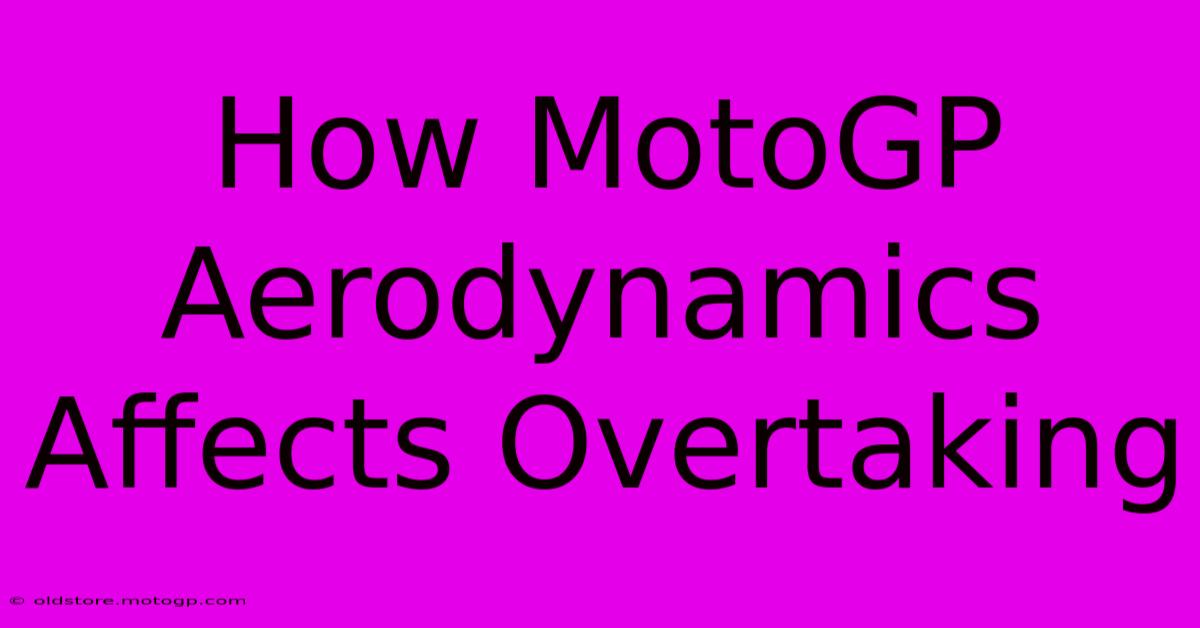How MotoGP Aerodynamics Affects Overtaking

Table of Contents
How MotoGP Aerodynamics Affects Overtaking
MotoGP racing is a relentless battle for position, a high-stakes game of inches where overtaking maneuvers are often the difference between victory and defeat. While rider skill and engine power are crucial, the often-overlooked factor significantly influencing overtaking is aerodynamics. Understanding how aerodynamic forces impact a MotoGP bike's performance, particularly during overtaking attempts, is key to appreciating the complexity and excitement of the sport.
The Downforce Dilemma: Grip vs. Drag
Modern MotoGP machines generate substantial downforce, pressing the bike firmly onto the track. This improved grip allows for higher cornering speeds and harder braking, advantages crucial for establishing a strong racing line and setting up an overtaking maneuver. However, this downforce comes at a cost: increased drag. This drag significantly impacts acceleration and top speed, making it harder to close the gap on a competitor and execute a successful overtake.
The Aerodynamic Wake: A Rider's Worst Nightmare
When one bike follows closely behind another, it enters the turbulent airflow disrupted by the leading bike's aerodynamics. This turbulent air, known as the aerodynamic wake, drastically reduces downforce on the following bike, making it less stable and significantly hindering its ability to accelerate and brake effectively. This loss of grip can make overtaking extremely challenging and even dangerous.
The impact of this wake is felt most strongly:
- During braking: The reduced downforce makes braking less effective, increasing stopping distances and making it harder to close the gap before a corner.
- Through corners: The instability caused by the disrupted airflow makes it difficult to maintain a smooth and fast racing line, making it harder to position for an overtake.
- On acceleration: The increased drag combined with reduced downforce makes it difficult to accelerate out of corners and gain the necessary speed to complete an overtake.
Winglet Warfare: Shaping the Battle
The introduction of winglets and aerodynamic appendages has dramatically increased the downforce generated by MotoGP bikes. While these additions offer enhanced stability and cornering speed, they also exacerbate the effects of the aerodynamic wake. The larger the wings, the more disruptive the wake they create for following riders. This has led to an ongoing arms race in aerodynamic development, with teams constantly seeking ways to maximize downforce while minimizing drag and the disruption caused to competitors.
Overtaking Strategies in the Age of Aerodynamics
Given the challenges posed by aerodynamics, riders have developed various strategies to overcome the difficulties of overtaking:
- Slipstreaming: Riders strategically position themselves behind a competitor to benefit from the reduced drag in the slipstream, allowing them to gain speed before attempting an overtake. This requires precise timing and positioning, and a strong acceleration burst once the opportunity arises.
- Late Braking: A crucial element of overtaking is mastering late braking, relying on superior braking prowess and confidence to outbrake a competitor and position the bike for the overtake. However, with reduced downforce in the wake, late braking becomes a riskier proposition.
- Aggressive Line Selection: Choosing lines that minimize time spent in the competitor's wake is essential. This might involve taking a wider line through a corner or using a different braking point to avoid the most turbulent air.
The Future of Aerodynamics in MotoGP
As the technology continues to evolve, we can expect to see further refinements in aerodynamic design. While the focus on generating downforce remains paramount, teams are also exploring ways to reduce the disruptive effects of the aerodynamic wake. This might involve innovations in winglet design, bodywork shaping, or even active aerodynamic systems.
In conclusion, aerodynamics play a pivotal role in the art of overtaking in MotoGP. While downforce provides the grip needed for fast cornering, it simultaneously creates a drag and turbulent wake that hinder overtaking attempts. Understanding these aerodynamic forces, as well as the strategies riders employ to overcome them, is essential for a complete appreciation of this demanding and exhilarating motorsport.

Thank you for visiting our website wich cover about How MotoGP Aerodynamics Affects Overtaking. We hope the information provided has been useful to you. Feel free to contact us if you have any questions or need further assistance. See you next time and dont miss to bookmark.
Featured Posts
-
Moto2 Motorcycles The Perfect Machine
Feb 18, 2025
-
Cota Parking Lot Map Your Personal Parking Navigator
Feb 18, 2025
-
Unleash Your Inner Racer Cota Circuit Days Await
Feb 18, 2025
-
Queen Circuit Road Trip Budget Friendly Tips
Feb 18, 2025
-
Moto2 The Stepping Stone To Moto Gp Glory
Feb 18, 2025
